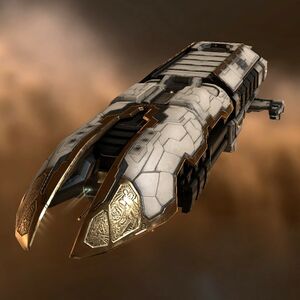Know Your Enemy - Destroyers
The following information was originally taken from The Altruist, a well-known EVE blog by former capsuleer Azual Skoll.
Destroyers are the dedicated frigate hunters of Eve. With 7 or 8 small guns apiece, destroyers put out far more damage than anything else of their size or cost. This firepower is backed up by substantial range and tracking bonuses (the whole class receives a fixed 50% bonus to optimal range and a 10% per level bonus to turret tracking speed), giving the destroyer no problems hitting its target both far away and up close. While larger and less nimble than a frigate, destroyers remain significantly more manoeuvrable than a cruiser and their signature radius remains much closer to that of a frigate, making the destroyer class proficient at getting under the guns of larger ships. They're also generally slightly tougher than t1 frigates, although their large number of high slots leaves then with with slightly fewer mids and lows than some of the front line combat frigates.
Given their strong tracking and excellent damage output, destroyers pose a significant threat to anything frigate sized. This makes destroyers an excellent choice for newer PVPers, giving you the potential to tangle with faction and t2 frigates and significantly increasing your range of available targets over those you would be able to engage in a t1 frigate, and all requiring relatively little in the way of isk or skillpoints.
Thrasher
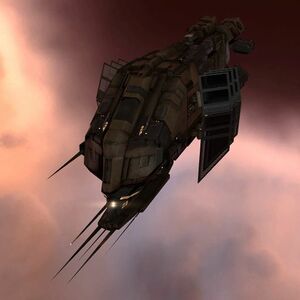
With the popularity of rifters, it's not surprising that the thrasher is quite a common sight. However, this ship has much more going for it than simply being a step up from a popular pvp frigate. With an 8/3/2 slot layout and 7 turrets, the thrasher is fairly versatile in terms of fitting. Along with the standard destroyer bonuses to range and tracking, the thrasher also receives a damage bonus - the only destroyer that does. The fact that this bonus is to damage rather than rate of fire is quite significant, as we'll see in a moment.
First of all, let's talk about autocannon thrashers. Due to the low powergrid requirement of autocannons, an AC thrasher has heaps of fitting room available - much more so than most other destroyers. A medium shield extender is generally the most common choice for tank, however a 2 slot armour tank with a 400mm plate is also fairly common. Either option can mount either an afterburner or mwd (MWDs tend to be more popular due to the dessy's lower overall speed), and there's even room for a neut or nos in the last high slot, making the AC thrasher a very well rounded boat. A MWD thrasher will do a little under 2km/s, while an AB fit will generally be closer to 750m/s - noticeably slower than a frigate, but still the fastest destroyer.
The damage output of the AC thrasher is excellent, with about 350dps being fairly normal - that's almost double the firepower of a typical assault frig - and with autocannons its tracking is exceptional. The tank is weaker than an assault frig, but higher base HP makes it naturally stronger than most t1 frigs, with between 5k and 8k EHP on a fairly standard fit. The optimal range bonus given to the dessy class in general doesn't really add much to falloff-centric autocannons, and with few low slots for tracking enhancers you can expect the range on the AC thrasher to be nothing too special - about 1+6km with close range ammo or 2+9km with barrage. Either a rocket launcher, neut, or nos is popular in the thrasher's 8th high slot - of these, the neut is the only one which might substantially affect your own tactics - if you're flying something active tanked, keep it in mind.
Shield tanked AC thrashers won't be packing a web, although those with an armour tank (or pure damage control tank - more common than you'd expect) may be carrying one so be wary. Providing the thrasher either has no web or has a MWD instead of an afterburner, most frigates should be able to dictate range if only due to their higher base speed. That said, the thrasher is relatively dangerous anywhere inside scram/web range and getting under its guns is pretty futuile given that it can out-track almost anything. In a larger ship, be careful of letting the thrasher get in under your guns - it'll be easier to dislodge than a frigate would, but its massed autocannons will make mincemeat of drones and it has more than enough dps to make a cruiser pilot regret letting them in close. In anything smaller than a cruiser, expect a challenging fight - even interdictors such as the sabre (the thrasher's t2 equivalent) can potentially be outmatched by this fearsome little ship. Your best bet in taking one on is probably to keep range and either blast it with larger guns or pick it apart from a range at which it can't respond, if you're able to do so. Of course, you should first make sure it's definitely an autocannon thrasher you're dealing with, as we'll discuss in a moment.
The good news for you is that the arty thrasher is generally very lightly tanked itself since all its grid is taken up by guns, and if you're able to survive the initial couple of volleys you should find it goes down quickly enough. Thanks to its substantial tracking bonus, expect the thrasher to get hits in even at close ranges (although you should still be able to reduce the quality and frequency of them significantly), and be careful making any manoeuvre which is likely to reduce your angular velocity. One way or another, any brawl against an arty thrasher is likely to be short.
Range on the arty thrasher is fairly strong thanks to the ship's optimal range bonus - generally about 11+11km with close range ammo and 280mms, or potentially as far as 53+14km with tremor and a dedicated sniping setup.
Arty thrashers are particularly effective in small wolfpacks, where three or more thrashers can knock out lighter targets such as scouting interceptors with their initial volley. These ships can also be very effective for hit and run attacks; warping in, splashing a target with a single volley, and warping out before their opponents can respond in kind. Be very careful if you come through a gate and find multiple thrashers sitting on the far side - if you're not able to warp out (for example, because of a bubble), your angular velocity during the first few seconds of your escape is going to be crucial! With a large enough group, even larger targets can be in danger (although in the solo and small gang situations we're focusing on, any large gang is a potential problem.
As a minmatar ship, the thrasher can put out any damage type. Explosive, EM and thermal tend to be most common (the high damage ammo types), although all variants feature a kinetic element. At longer ranges (autocannons with barrage and arty with tremor), expect a more predictable explosive with kinetic. Since the AC thrasher is usually shield tanked, thermal or EM damage are the better choices, with explosive or kinetic preferable against armour tanks. Due to the innate minmatar EM resist, I'd recommend thermal as a good choice if you're unsure (which also happens to be the best damage type to use against the un-tanked variant.
Catalyst
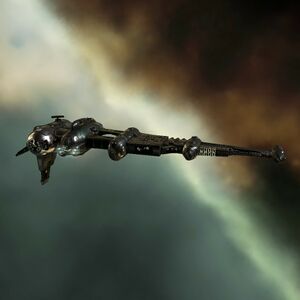
If you thought the damage output of the thrasher was good, the catalyst continues to amaze! It gets 8/2/3 slot layout and 8 turrets (plus one drone!) compared to 7 on the thrasher and cormorant. It also receives a falloff bonus, which while fairly useless for rails does give blasters a little more range flexibility. Fitting a tank to the catalyst can be difficult unless it uses electron blasters or 75mm rails (which are generally eschewed on account of their poor range and dps respectively), however as with most gallente ships it has excellent structure HP, meaning a damage control alone can provide a moderate buffer of around 5k-6k EHP. Because of this, those extra low slots are generally used for beefing up the catalyst's already significant damage output, rather than for additional tank. In terms of raw numbers, a fairly normal high damage fit for a blaster catalyst can put out close to 500dps using CN antimatter - more than most cruisers.
The main weakness of the catalyst is range control - it's slightly slower than the thrasher (typically 1.7km/s with MWD, 700m/s with AB), and it needs to be relatively close to bring its full damage to bear. With only two mid slots the catalyst can't fit a web either, which can make holding a solo target at blaster range something of a challenge. The catalyst's range isn't as short as most other blaster ships however; with its optimal and falloff bonuses a catalyst with ions can hit out to around 1.5+4km with antimatter, or 4+5km with null (neutrons are difficult to fit, although you do see them). If you're able to fight outside that range it should be fairly easy to simply keep this ship at arm's length and avoid the majority of the it's damage output, and even just forcing it to load null is a start. If you're not able to keep range or you find yourself starting the fight at point blank, expect a very challenging fight unless you have both a stiff tank and a weapon system capable of tracking (or otherwise hitting) a target at that range.
While most catalyst pilots opt for the pure damage control tank, it's not uncommon to see them fitting a small to moderate armour tank too (either a light buffer, a rep, or both). If present, this will generally be stronger than the light buffer tank you might encounter on a thrasher, but not enough to cause a significant problem. It will also likely mean a reduction in the catalysts own damage output due to the loss of slots for magstabs, and potentially range too if the gun size is dropped.
In a gang, the catalyst's dps output shouldn't be underestimated, and its fairly weak tank means that it should probably be primaried early on. An effective tactic for blaster catalysts is to join the fight once it's already underway and when primaries have been called, allowing it to quickly close range on the already tackled targets without facing incoming fire itself. Since it generally has to get close before it can deal damage, the catalyst is generally less dangerous to light suppose ships than the thrasher or coercer, since they should usually be fast enough to evade it.
I haven't really mentioned rails on the catalyst, and that's for a reason - you don't really see them. It's possible to do, and the rail catalyst still has relatively strong damage output, however its falloff bonus doesn't really help with optimal-heavy railguns and those looking for a longer range option generally find any of the other three dessys better suited to the task.
As a blaster ship, the catalyst's damage output will be all or mostly a mix of kinetic and thermal (more kinetic up close, more thermal at range). Since it's generally damage control tanked, your own damage type doesn't really make much difference (although you might want to go with explosive or kinetic, just in case it's fitting an armour tank).
Cormorant
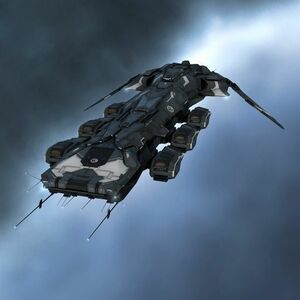
As with all caldari hybrid boats, the cormorant seems to have been designed for sniping - it gets a 10% bonus to optimal range per level (on top of the 50% fixed bonus all destroyers receive), allowing it to hit at ranges that other destroyers can only dream of (potentially as far as 95+12km on a full sniping fit, although this is fairly uncommon). In terms of slot layout, the cormorant has 8/4/1 with 7 turrets. With one low slot however, the damage output of the cormorant starts low and is difficult to change.
While the range of a sniping rail cormorant is impressive, the damage it puts out at this range is pretty poor and it doesn't have the alpha strike of the thrasher to make flyby sniping really viable. A mid-range rail cormorant is probably more of a threat, dealing moderate dps at 15-20km and putting pressure on lightly tanked ships like interceptors trying to tackle another target.
Blaster cormorants are also fairly popular - while they lack anything like the raw dps output of the catalyst, the cormorant can bring to the table two things that the catalyst lacks: a web, and a strong tank. With 4 mid slots the cormorant is a natural shield tanker, and a medium shield extender is fairly standard for a blaster fit. Unlike the thrasher, the cormorant's powergrid is quite weak and blasters are grid-intensive, meaning fitting mods will likely be required in order to fit one (either giving up the ship's only low slot for a MAPC, or relying on rigs to make room. This also means that the cormorant is less likely than the thrasher to be fielding a neut or nos in it's 8th high slot since it simply lacks the grid to do so.
In general, the blaster cormorant is less of a threat than an AC thrasher, however it's a flexible ship and has the advantage of being constantly underestimated (a mistake which I hope, after reading this, you won't be so quick to make yourself). The web provides blaster cormorants with relatively good range control (although it's still generally the slowest of the dessys, at 1.5km/s under MWD or 650m/s with AB), and its optimal range bonuses take a little bit of pain away from its usually short ranged blasters - around 2+2.5km with antimatter/3+1km with void, or a relatively good 6+3.5km with null. Despite not quite having the firepower of the other dessys, the cormorant still puts better dps than most assault ships (typically around 250 with antimatter) and fields a stronger tank than the thrasher (usually around 8k EHP).
It's worth noting that due to its generous allocation of mid slots a cormorant in gang will often be set up as fast-locking tackle or electronic warfare rather than as an anti-support dps platform. This can potentially make the cormorant a greater threat to your gang than you would assume, particularly when packing tracking disruptors or something similar. What it also means of course is that tank is likely to be minimal, so removing it from the field should be easy.
As a shield tanker, EM or thermal damage is generally the best way to deal with the cormorant (since the rigs are often used for powergrid, EM is usually the best bet). Its own damage output will be a mix of kinetic and thermal.
Coercer
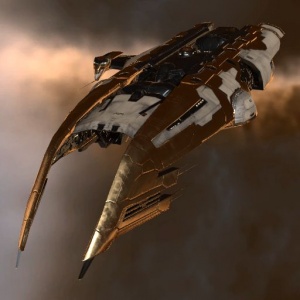
If the cormorant rules long range and the catalyst dominates at point blank, the coercer is most definitely the king of mid range damage. While all long-ranged turrets benefit from the destroyer's optimal range bonus, pulse lasers are the only close range weapon system which is heavily optimal ranged based (as opposed to autocannons which are primarily falloff, and blasters which are a mix). This means that while AC thrashers and blaster cormorants/catalysts are limited to fighting close, a pulse coercer with scorch can hit out at close to maximum point range for almost its full damage. That damage is pretty nice too - with a 8/1/4 slot layout and 8 turrets, the coercer has strong base damage and plenty of low slots with which it can enhance that. It's bonus to turret cap useage isn't really exciting, but with 8 turrets it's definitely needed!
The coercer's big disadvantage of course is the one we already discussed when we looked at the retribution - 1 mid slot. however thanks to its excellent damage output, the coercer can actually be a surprisingly good solo ship - it can kill frigates so quickly that by the time its prey realises the fight is not going to go their way, it's often too late for them to escape. Because of this and its impressive range, the coercer actually finds quite a bit of use as a kiting ship - enticing lightly tanked frigates to give chase and then taking them down as the frigate pilot attempts to tackle it.
A kiting coercer generally features the largest pulse lasers available, a MWD, and low slots dedicated to damage, range and speed. With a single speed mod, an MWDing coercer is about as fast as the thrasher (1.8km/s or so), with good agility and able to put out almost 300dps to typical ranges of 22+3km or thereabouts. Should a target get in close, the coercer can instantly switch crystals to put out upwards of 350dps at around 7+3km, all with the exceptional tracking native to the destroyer class. The weakness of the kiting coercer is its fragility - they're generally completely untanked, leaving them with about 3.5k EHP and no way to escape tackle once scrammed. Frigates should be wary of the coercer's damage output even up close, however its survivability against any larger ship on the field relies entirely on its ability to evade tackle and thus evade fire.
In addition to the popular kiting fits, some coercer pilots will use their high low slot count to fit a decent armour tank (although doing to requires dropping to smaller turrets in order to conserve grid). An armour tanked coercer is generally one of the toughest destroyers (typically around 10k EHP with the potential for a mix of buffer and rep), however it's also slower - usually around 1.6km/s with MWD or 600m/s with AB (with AB fits also generally being tankier). Tanked coercer are generally fit as brawlers with afterburners and pulse lasers, although due to their lower damage output they generally make poor solo ships and are relatively uncommon. Beam coercers are equally are, and aren't substantially different to a pulse coercer other than in terms of range and tracking - range on beams is less impressive than with arty or rails, and without any possibility of a web they are easy to counter simply by getting close.
In all, the kiting coercer is by far the biggest threat, at least against small ships (due to its lack of tackle, the coercer in general is not much danger to bigger ships unless it has friends to provide tackle). Treat kiting coercers as you would any other kiting ship - avoid chasing them if you're not confident that you can get tackle quickly, and try to draw them close before making your move if possible. Remember that it can't tackle you, and make the decision to get out early - if you leave it until the last minute, then it's probably already too late.
In gang, be aware of the coercer's strong damage output, especially if you're flying light ships - a pulse coercer presents a significant threat to light tackle and support. That said, it can't pin you down so it should be fairly easy for the more fragile ships in your gang (such as fleet inties and ewar) to evade it providing they pay close attention to their surroundings.
Talwar
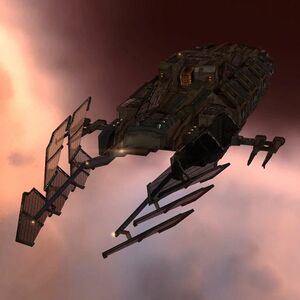
Algos
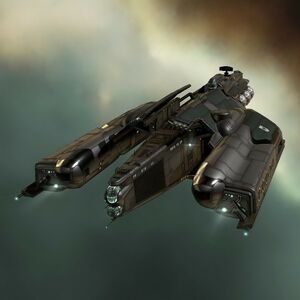
Corax
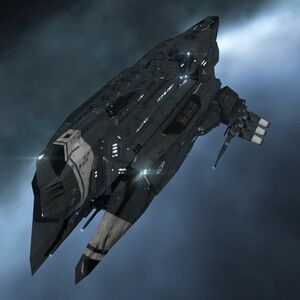
Dragoon
